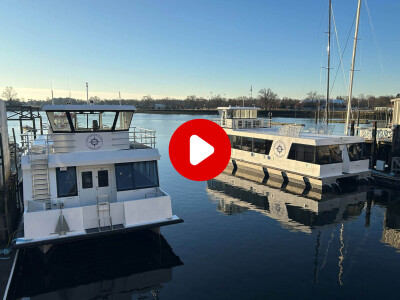Finally achieving some traction with federal regulators, the commercial fishing industry is working to solidify its place at the table with the U.S. offshore wind energy industry.
But big obstacles remain. One is fishermen’s continuing distrust of their soon-to-be-new neighbors on the outer continental shelf.
“All of the developers have approached us…and we’re having a hard time finding people who are willing to be FLOs (fisheries liaison officers),” said Annie Hawkins, executive director of the Responsible Offshore Development Association (RODA), a coalition of fishing groups that organized to deal with the advent of ocean wind power.

The Coast Guard and BOEM are considering fishing industry proposals for safe transit lanes (light blue) for wind energy areas off southern New England. Coast Guard image
The group helped convince the federal Bureau of Ocean Energy Management in fall 2018 to put wind developers on notice that safe transit lanes for fishing vessels will be a condition for building turbine arrays in southern New England waters. RODA’s proposed lanes are now part of a review process that will bring a draft proposal later this year, said Coast Guard Lt. Cmdr. Joshua Buck.
Fishermen need to get their expertise into those deliberations, but many of them eye with suspicion anyone from their ranks who takes a job building communication between the industries, Hawkins told a packed workshop at the IPF19 wind energy conference in New York April 10.
“ ‘Sell the wind thing,’ is how they see it,” she said.
With the first commercial offshore wind energy project in federal waters to start construction in 2020, RODA brought some experienced hands to the conference: fishermen Merlin Jackson and Colin Warwick, who advocate on behalf of fishermen in the United Kingdom and Scotland on issues of offshore wind power development there.
“Merlin was on the cutting edge, he had a lot to deal with and no backup,” Warwick said in introducing themselves, recounting how he in turn got involved “trying to repair the damage that was done” in those early years.
Jackson, a fisheries liaison officer for the Thanet Fishermen’s Association, said government and industry looked simply at wind conditions and suitable bottom for turbine foundations when they “drew a bullseye” on the Thames River estuary, without considering the effect on traditional fishing.

Fishermen Colin Warwick, left, and Merlin Jackson, who represent fishermen in the United Kingdom on offshore wind energy issues, listen during a workshop discussion at the IPF19 conference in New York April 10, 2019. Kirk Moore photo
Now the region’s fishing industry “is on a knife edge … the ones that are left are the real hard-core guys who have been at it for years and are hanging on,” said Jackson.
In the North Sea off Scotland, fishermen are working around the wind industry and “pricewise, it’s been fine” with high demand for seafood now and boatyards backed up with orders for new vessels, said Warwick, chairman of a national fishing liaison effort.
But the pressure is still there, and “the appetite for renewable energy will increase,” said Warwick. “The ports that suffer the most are the small boats and smaller fleets that can’t move far.”
In retrospect fishermen were late getting involved, said Warwick: “Fishing is a knowledge-based industry. Unfortunately we don’t share our knowledge with anyone … It’s very competitive.”
Distrust among fishermen was a problem in the U.K. too, said Jackson. After meeting April 8 with fishermen in Montauk, N.Y., at the eastern end of Long Island, Jackson said he could see “the stigma here is even worse.”
But there has been some successful communication from fishermen to the wind industry. Warwick cited Equinor’s Hywind Scotland project, the first commercial floating turbine installation. Fishermen’s recommendations for laying cable to the turbines preserved some of their fishing bottom, while sparing Equinor from deepwater drop-offs that could have endangered the cable.
In those dialogues, “we have a group of good fishermen and good developers…If you can keep talking to each other, you’ll get to a good place.”
In late March RODA arrived at a formal agreement with BOEM and the National Oceanic and Atmospheric Administration to work cooperatively and share fisheries information for the planning process.
On April 8, RODA and its partners announced a new initiative: the Responsible Offshore Science Alliance, a forum with funding from wind energy developers to foster new research on how wind development may affect the ocean ecosystems and fisheries.
“It will further seek to address broader aspects of the ocean environment that offshore fisheries and wind energy activities occupy, including pre-facility baseline activity and resource status, ecosystem-based fishery management, socioeconomic effects, cumulative impacts, and other relevant science,” according to a statement from organizers.
“It will be structured with an executive council, research council, and topic-and geographic specific subcommittees comprised of scientific and technical experts of diverse affiliations.”




.jpg.small.400x400.jpg)
